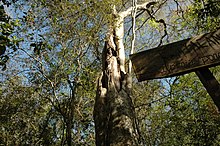Libidibia
Libidibia is a genus of flowering plants in the legume family, Fabaceae. It belongs to the subfamily Caesalpinioideae.
| Libidibia | |
|---|---|
 | |
| Libidibia paraguariensis in Chaco National Park | |
| Scientific classification | |
| Kingdom: | |
| (unranked): | |
| (unranked): | |
| (unranked): | |
| Order: | |
| Family: | |
| Subfamily: | |
| Tribe: | |
| Genus: | Libidibia (DC. 1825) E. Gagnon & G. P. Lewis 2016 |
| Type species | |
| Libidibia coriaria (Jacq. 1763) Schltdl. 1830 | |
| Species | |
|
See text | |
| Synonyms[2] | |
| |
Species
Libidibia comprises the following species:[2]
- Libidibia coriaria (Jacq. 1763) Schltdl. 1830—Divi-divi (Mexico, Central America, the Caribbean, northern South America)
- Libidibia ferrea (Mart. ex Tul. 1844) L. P. Queiroz 2009—Brazilian ironwood, leopard tree
- var. ferrea (Mart. ex Tul. 1844) L. P. Queiroz 2009
- var. glabrescens (Benth.) L. P. Queiroz 2009
- var. leiostachya (Benth.) L. P. Queiroz 2010
- var. parvifolia (Benth.) L. P. Queiroz 2009
- Libidibia glabrata (Kunth 1823) C. Castellanos & G. P. Lewis 2012
- Libidibia monosperma (Tul. 1844) E. Gagnon & G. P. Lewis 2016
- Libidibia paraguariensis (D. Parodi 1862) G. P. Lewis 2008—Ibirá-berá, guayacaú negro, Argentinian brown ebony (Argentina, Bolivia, Brazil, Paraguay)
- Libidibia punctata (Willd. 1809) Britton 1924—Quebrahacha, Kibrahacha in Aruba
- Libidibia sclerocarpa (Standl. 1919) Britton & Rose 1930
gollark: Ah.
gollark: It looks like it's doing something ineffable to rsp.
gollark: What's it doing?
gollark: So I'm not sure what you plan to compare it with.
gollark: Well, that's actually one picture.
References
- Legume Phylogeny Working Group (LPWG) (2017). "A new subfamily classification of the Leguminosae based on a taxonomically comprehensive phylogeny". Taxon. 66 (1): 44–77. doi:10.12705/661.3.
- Gagnon E, Bruneau A, Hughes CE, de Queiroz LP, Lewis GP (2016). "A new generic system for the pantropical Caesalpinia group (Leguminosae)". PhytoKeys. 71 (71): 1–160. doi:10.3897/phytokeys.71.9203. PMC 5558824. PMID 28814915.
This article is issued from Wikipedia. The text is licensed under Creative Commons - Attribution - Sharealike. Additional terms may apply for the media files.